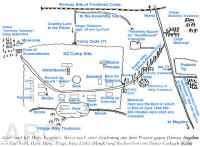 |
| Camp Map |
In
November 1941, the
Minsk Security Police
and the SD (
Sicherheitsdienst) established a new camp at
the former kolchos (collective farm, 200 hectares / 500 acres) "Karl Marx" in the village of Maly Trostinec,
12 km southeast of
Minsk and 1 km south of
Bolshoi Trostinec village. The camp site had been selected in
September 1941. It measured approximately 200 x 200 m / 4 hectares.
Initially the camp was intended to supply the local Nazi forces with food. In addition a mill, sawmill, locksmith's shop,
joinery, tailoring, shoemakers, asphalt works and other workshops were built. Jews and Soviet POWs
built barracks for around six hundred mainly Jewish slave labourers and their guards.
The prisoners, selected for work in the camp, were kept at first in a large barn and in 20 cellars, which were
formerly used by the local farmers for cooling potatoes, vegetables and meat. Later they were housed in damp
barracks, where bunks were constructed from thick unshaved wooden planks in three tiers. There was no bedding
or mattresses; the people slept on straw.
From
March 1942, the camp was surrounded by a threefold barbed wire fence
(the middle one electrified), and
wooden lookout towers were erected at the corners of the perimeter, which was guarded 24 hours a day. A
guardroom was located close to the entrance to the camp, and a gallows was erected. In
mid-March 1942, partisans
attacked the camp and killed the guards; therefore the Germans increased the total number of guards on 250,
encircled each barrack with a barbed wire fence, posted additional guards around the barracks, installed runways
for dogs, and placed machine-gun nests around the entire site. A subterranean bunker was built, with a tank
standing atop it. Those people who were to be liquidated the next day were held in the bunker.
The 150 men of the camp staff were free to beat, shoot or hang any prisoner without any further authority.
 |
| Execution Site Blagowshtchina * |
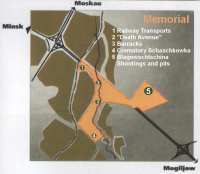 |
| Memorial Map* |
Like the camps of
Aktion Reinhard, the buildings of Maly Trostinec were
intended to be no more than temporary structures. The camp came to exist for the principal purpose of killing
people and appropriating their few remaining possessions. However, unlike the
Aktion Reinhard camps and
Auschwitz-Birkenau, there were no fixed killing facilities. In this respect,
perhaps the killing site Maly Trostinec most closely resembled in character was
Chelmno, although at Maly Trostinec murder was principally committed by shooting.
Mobile gas chambers (gas vans) only played a subsidiary,
if significant role. Initially, victims were transported to
Minsk, which had
been intended by
Reinhardt Heydrich to
play a more prominent part in the "Final Solution". German reverses on the Eastern front prevented this,
and transports to the East from the
Reich and the "Protectorate of Bohemia and Moravia", announced for
January 1942, were cancelled as a consequence.
Operating in a manner similar to that of the death camps of
Aktion Reinhard, the SS men, responsible for
the executions at Maly Trostinec, met the transports arriving at the goods-railway station in
Minsk.
The deported Jews were informed that they would be transferred to houses and estates around
Minsk, but before
this they had to leave their suitcases which would be forwarded by trucks. The Jews had to also leave their
ID-cards, money and valuables for which they received receipts. The victims were completely unaware of their
fate. A group about 20 - 80 specialists were selected from every transport and they were sent to the
Minsk Ghetto
or to the work camp at Maly Trostinec.
Between May 1942 and autumn 1943 the remainder
were taken by trucks directly to the execution site in the
Blagowshtchina forest.
Before they were killed, they had to undress and hand over their valuables. Then they had to march in underwear
to the 60 m long and 3 m deep pits where they were shot in the neck by squads of up to 100
Sipo and
SD-men.
A special group of Russian forced labour workers had to dig out these pits (in winter the pits were created by
detonating dynamite) and fill them up after the killings. Finally, using bulldozers or tractors, the pits
were levelled.
During the unloading of the victims the SS men were very brutal.
To cover the shots and screams while the Jews were killed, music was played from a gramophone, amplified by a
loudspeaker. The population in the neighbouring villages could not hear the executions. Everything was well
organised so that the victims had no time or opportunity for resistance. Each SS man knew his "duty" during
the mass murder, describing the process in detail in post-war trials.
There had been mass executions of local Jews in
Minsk since
August 1941, which continued in and around
the city until the ghetto there was liquidated on
21 October 1943. Beginning on
10 November 1941 with the
arrival of the first transport from the
Reich (990 Jews from
Hamburg), the
Minsk Ghetto became, in effect, a transit camp for those earmarked for
extermination. Most of the Jews from
Hamburg were transported directly
to Maly Trostinec (
Blagowschtschina) to be killed there.
In
April 1942,
Heydrich ordered
Eduard Strauch, the commander of the Security Police and Security Service in
White Ruthenia, to kill the deportees immediately on arrival. After the first phase of deportations to
Minsk had been concluded in
November 1941,
16 trains with more than 15,000 people from cities in the
Reich,
the "Protectorate", Poland, Austria and France arrived at the
Minsk goods station
between May and October 1942.
Starting on
10 May 1942, and continuing during the early morning hours (4 - 5 a.m.) on
Tuesdays and Fridays thereafter, most of the deportees were brought to the primitive "railway station" at
Maly Trostinec, which was sited at a dead-end railway track in the camp.
From
August 1942 onwards the trains were routed via a branch line much closer to
the estate itself, and from that time on it was here that disembarkation and selection took place.
The few not chosen for immediate
execution were formed into
Sonderkommandos, (special detachments). They were kept in the camp under
heavy guard, and forced to take the bodies of those killed to pits where they were buried or burned, to
sort out the effects of those who had been murdered for shipment back to Germany, or on camp maintenance.
From time to time these slave-labourers were subject to selection and murdered in their turn. In addition
to the shooting squads, four gas vans were in operation in the
Minsk area, some
of which began operating at Maly Trostinec at the
beginning of June 1942.
Known locally as "Dushegubki" ("soul killer" in Russian), they accounted for many victims.
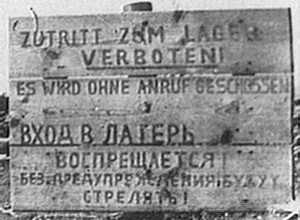 |
| Original Sign: Shooting without Warning! * |
Tens of thousands of Jews from Byelorussia, and other European countries were killed at Maly Trostinec.
Trainloads of Jews from Austria, Germany and the Czech Republic arrived and were exterminated. Transports
were organized in
Berlin, Hannover, Dortmund, Münster, Düsseldorf,
Köln, Frankfurt am Main, Kassel, Stuttgart, Nürnberg, München, Breslau, Königsberg, Wien,
Praha, Brno and
Terezin (Theresienstadt).
After the first transport left
Wien for Maly Trostinec on
6 May 1942, a further 8 transports containing
7,500 Viennese Jews followed, along with several hundred Austrians taken from
Terezin. Only 17 people are
known to have survived among the almost 9,000 Austrian Jews deported to Maly Trostinec.
Between 14 July 1942 and 22 September 1942, five transports, each containing
about 1,000 people, arrived at Maly Trostinec
from
Terezin. One of these transports left on
4 August.
40 deportees were removed from the train in
Minsk.
The remaining 960 Jews were ordered off the train, loaded into gas vans and driven into the forest.
Of 1,000 Jews in a further transport which left
Terezin on
25 August, 22 younger
men were taken to work on a farm; two of them escaped to join the partisans. One was killed in action. One
survived the war; all others in the transport were gassed.
A report, prepared for
Himmler on
23 March 1943 by
Richard Korherr of the SS statistical department, summarised
the number of Jews deported up to
31 December 1942 from the
Reich and the
"Protectorate" area: Germany 100,516, Austria 47,555, "Protectorate" 69,677; a total of 217,748. There were
to be further transports from Germany in
1943. Many of those transported in
1942 - 1943 from these countries were destined for Maly Trostinec, and death.
In
May 1943, approximately 5,000 people were held at the camp site. 500 victims
were liquidated every day, by use of gas vans, which went to and from
Minsk
and Maly Trostinec every day, carrying 75 people per journey.
In
August 1944, it was estimated that 40,000 foreign Jews had been
killed in the
Minsk Ghetto and its suburbs. More recent research suggests that
in Byelorussia as a whole, the Nazis murdered at least 55,000 Jews from the
Reich and the "Protectorate".
Maly Trostinec also served as a killing site for the Jews of
Minsk and the
surrounding area. Since Maly Trostinec was only one of several places where Jews were murdered in the
Minsk region, it is difficult to arrive at an accurate figure for the number
of Jews killed at the camp. There were about 400,000 Jews living in Eastern Byelorussia in
mid 1941.
Approximately 80%, or 320,000 Eastern Byelorussian Jews, were murdered during the occupation. Relatively
few were transported to the Polish death camps; most were killed on the spot. In addition, the Jewish pre-war
population of Eastern Byelorussia had been swollen by an influx of refugees from Poland, fleeing before the
German invaders.
But Jews were by no means the only victims. Many thousands of Byelorussian civilians, Byelorussian partisans
and, most of all, Soviet POWs were murdered at Maly Trostinec. Unlike the transports from the West, there
were no lists to record the number and identities of those killed. For this reason, and because the Germans
destroyed most of the records about the camp, as well as the obliteration by them of much of the physical
evidence, the estimated death-toll of the Maly Trostinec complex has varied enormously. Estimates place
the total number of victims at 206,000 (W. Benz: "Dimension des Völkermords", "Mordfelder"). In
1995, following
further examination of archival material, the number of those killed was revised upwards to 546,000, although this
figure may be taken to refer to the
Minsk area as a whole. For example,
between September 1941 and October 1943, mass shootings were carried out in the
Blagowshtchina forest, 5 km from Maly Trostinec, where an estimated number
of 150,000 people were killed, before the executions site was moved in
October 1943
to the
Shashkowa forest. Here more
than 50,000 people were murdered.
It should be stressed that many of these estimates of the numbers of victims are based upon
Soviet investigations organised in Minsk in
1944 - 1945. It is probable that the
actual number killed, either by shooting or in gas vans, was lower. The German historian, Christian Gerlach, has
calculated the total number of victims of Maly Trostinec at 60,000. What is indisputable is that Byelorussia
suffered the highest overall loss of life of any former Soviet Republic during WW2.
In
June 1942
Heinrich Himmler ordered
Paul Blobel
to erase all traces of the mass killings in the East.
Blobel formed the
Sonderkommando 1005 for the purpose of exhuming and burning the corpses of
those murdered. The first operations of
Sonderkommando 1005 in the Soviet Union began at the
end of September 1943 at
Babi Yar, outside
Kiev. Seven weeks were
allotted for conducting the
Sonderkommando 1005 operations in Byelorussia, with
disinterment and cremation beginning at Maly Trostinec on
27 October 1943. The camp
commander received police reinforcements as well as 100 Jews who were ordered to undertake the hideous task. The Jews
refused to do so and were immediately killed in gas vans. In their place, a group from the
Minsk prison was allocated, and promised freedom on completion of the work. Instead,
they too were gassed.
Whilst working, and at night in the bunker in which they were housed, they had been chained together in order
to prevent escape. This was common practice of
Sonderkommando 1005, wherever it operated. The
witnesses were to be destroyed along with the evidence. 34 mass graves (some up to 50 m long) in
Blagovshchina forest were opened, a number of which contained as many as
5,000 corpses. After the cremation of around 100,000 corpses was completed, a team of Soviet POWs were made
to sift the ashes in search of gold. The ashes were used as fertilizer for the camp fields.
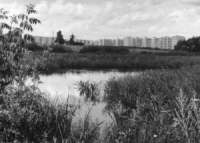 |
Shaskowa Lake, where the
Gas Vans were cleaned * |
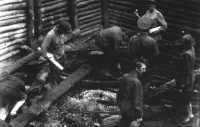 |
A Soviet Commission
inspects the pit in 1944 * |
A cremation facility was also built in
Shaskowa forest (500 m away from the camp)
in the
autumn of 1943, where
the bodies of those killed by shooting and gassing were incinerated. Here, from inception, the Germans tried
arranging an execution pit as a primitive crematorium. A 3 m high wooden fence was built around the site.
6 parallel rails (10 m long) were installed at the bottom of a 4 m deep pit, with an iron grate placed on them.
The pit was supported on three sides with iron panels. The fourth side served as a ramp where the gas vans unloaded
the bodies of the victims, directed by deputy Camp Commander
Rieder. The 30
workers who built the cremation facility, were then shot and burned in the pit. This cremation pit was visible
until the
1960's. A nearby lake served for cleaning the gas vans before they returned to
Minsk.
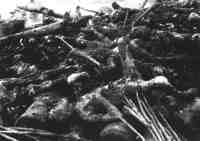 |
| Kolchos Barn: Cremated Victims * |
On
28 June 1944, as the advancing Red Army approached Maly Trostinec, Russian
airplanes attacked the camp.
That day, the camp guards (Latvian, Ukrainian, White Russian, Hungarian and Rumanian SS auxiliaries) were
replaced by a special SS detachment (Germans). This detachment locked all surviving prisoners in barracks.
These prisoners were Russian civilians and Jews from
Minsk and elsewhere. The
barracks were set on fire. The SS shot at all those who fled the blazing buildings.
About 20 Jews managed to evade the fire and the bullets;
they hid in the nearby forest until the arrival of the Red Army six days later. Amongst the few survivors of
Maly Trostinec, they were taken to
Moscow by their liberators and kept for
two years in a Siberian camp before being released in
1946.
On
28 or 29 June 1944, the chief of the
Sipo and SD in
Minsk,
Heinz Seetzen, ordered the execution of the remaining 6,500 prisoners in the
Wolodarski Street Prison and the
Schirokaja Street Camp in
Minsk.
Between 28 and 30 June 1944 they were locked in the former kolchos barn in Maly Trostinec,
then shot
and burned: The first victims had to stand on a layer of firewood, then they were shot. Their bodies were covered with
another layer of wood. Then the next victims had to climb on the pile and were shot. This went on until the last layer
of bodies reached the top of the barn. Three other funeral pyres were erected beside the barn, then the whole
apocalyptic arrangement was burned down. On
4 July 1944, 4 days after this action,
Soviet troops arrived at the site.
The burning pyres were still visible.
On
30 June 1944, the Germans had burned the remainder of the camp to the ground.
Witnesses' testimonies of mass murder at Maly Trostinec became available soon after the Red Army liberated
Minsk.
A resident of
Bolshoi Trostinec described how tractors had been used to level
the bodies in the burial pits
in order to enable further bodies to be buried at the same place. Another witness told how a group from
Minsk prison had been brought to Maly Trostinec as part of the
Sonderkommando 1005 operation. A member
of the SS described how 18,000 Jews from
Minsk had been murdered at the
end of July 1942. At that time, four
gas vans operated 24 hours a day, whilst other trucks were used to transport the victims to Maly Trostinec for
shooting.
In post-war trials, conducted in West Germany in connection with crimes committed at Maly Trostinec,
Otto Erich Drews, Otto Hugo Goldapp and Max Hermann Richard Krahner
were all sentenced to life imprisonment for their part in the killing of members of
Sonderkommando 1005. Others were given varying sentences in connection with war crimes carried out in the
Minsk area, including Maly Trostinec. A number of trials took place in
the Soviet Union. Overall, the number tried represented a small minority of the perpetrators.
Of all of the extermination sites in Poland and the former Soviet Union, perhaps least is known in the West
about Maly Trostinec. Unlike
Majdanek and
Auschwitz-Birkenau,
little physical evidence remained of the camp and there were few survivors. There was no overall command structure,
as existed in the
Aktion Reinhard camps, and thus a less organised pattern of crime. Insufficient research
has been conducted in the West into Maly Trostinec, yet those killed there may have been comparable in number to
the victims of
Majdanek or
Sobibor, and may possibly have been greater.
With increased access to previously classified Soviet and Eastern bloc documentation, it is to be hoped that this
anomaly will eventually be rectified.
Sources:
Hilberg, Raul.
The Destruction of the European Jews Yale University Press, New Haven 2003
Gilbert, Martin.
The Holocaust Collins, London 1986
Gutman, Israel, ed.
Encyclopedia of the Holocaust Macmillan Publishing Company, New York 1990
Epstein, Eric Joseph and Rosen, Philip.
Dictionary of the Holocaust Greenwood Press, Westport / Connecticut 1997
Poliakov, Leon.
Harvest of Hate: The Nazi Program for the Destruction of the Jews of Europe Syracuse University Press, 1956
Buscher, Frank.
Investigating Nazi Crimes in Byelorussia: Challenges and Lessons
Justiz und NS-Verbrechen
Gerlach, Christian. Kalkulierte Morde. Die deutsche Wirtschafts- und Vernichtungspolitik in
Weißrußland 1941-1944, Hamburg 1999
Kohl, Paul. Trostenez - Das Vernichtungslager bei Minsk In: "Existiert das Ghetto noch? Weißrußland:
Jüdisches Überleben gegen nationalsozialistische Herrschaft." Edited by Projektgruppe Belarus. Berlin-Hamburg-Göttingen 2003.
Langenheim, Henning. Mordfelder Elefanten Press, Berlin 1999
Photos:
Trostenez - Das Vernichtungslager bei Minsk - Official booklet from the
Belarussian State Museum of History of the Great Patriotic War
*
Mordfelder *
© ARC 2005














